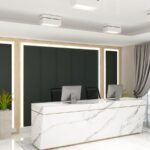Visual merchandising plays a pivotal role in the success of a retail store. It is a powerful tool that can be used to attract customers, increase sales, and build brand awareness. Effective visual merchandising is a strategic combination of design elements, product placement, and store layout.
In this article, we will explore the basic principles for designing and placing visual displays in retail, highlighting the importance of visual merchandising and providing insights into creating attractive and engaging store environments for you.
Basics first!
There are a number of basic principles that can be used to create effective visual displays. These principles include:
-
- Balance: A well-balanced display creates a sense of harmony and order. The two types of balance are symmetrical and asymmetrical. Symmetrical balance is achieved when the elements of the display are evenly distributed. Asymmetrical balance is achieved when the elements of the display are arranged in a way that creates visual interest.
-
- Contrast: Contrast is the best way to evoke a visual interest. Contrast can be created by using different colors, textures, or shapes. For example, a light-colored product can be placed against a dark background to make a charming contrast.
-
- Emphasis: Emphasis is used to draw attention to a specific display element. This can be done by using color, size, or placement. For example, a large product can be placed in the centre of the display to create emphasis.
-
- Repetition: Repetition is a simple but effective way to produce a sense of unity. This can be done by using the same colors, textures, or shapes throughout the display. For example, a checkerboard pattern can cause a sense of repetition.
-
- Proportion: Proportion refers to the relationship between the different elements of the display. The elements of the display should be scaled to each other for a visually pleasing composition.
-
- Hierarchy: Hierarchy is used to create a sense of order and importance within the display. The most essential elements of the presentation should be placed in a way that draws attention to them.
-
- Clarity: The display should be easy to understand and navigate. The customer should be able to see what is being displayed and understand the purpose of the display.
- Branding: Last, but most important, principle of visual merchandising is that the display should reflect the brand identity of the retailer. The colors, textures, and shapes of the display should be consistent with the brand’s overall image.
Keeping these principles in mind, let us help us execute them in the Placement of the visual displays of your store.
Creating a Lasting First Impression
First impressions are crucial in retail, and the design of a store’s visual displays sets the stage for a customer’s shopping experience. A well-designed window display grabs the attention and entices the passersby into the store. It should showcase the store’s identity, highlight key products, and evoke curiosity. By using eye-catching visuals, creative props, and appropriate lighting, fashion retailers. It can instantly convey their brand’s style and create a desire for customers to explore further.
Harmony and Cohesion in Design
The visual merchandising displays within the store should be harmonious and cohesive, creating a consistent visual narrative. Consider the store’s overall theme, target audience, and product assortment when designing the displays. A coherent color palette, consistent use of materials, and complementary product arrangements contribute to a visually pleasing environment.
For instance, a beach-themed display in a summer fashion store could feature pastel hues, natural textures, and beach accessories, creating a cohesive and inviting atmosphere.
Product Placement and Hierarchy
Strategic product placement is essential in visual merchandising. By using the principle of hierarchy, retailers can guide customers’ attention and promote specific products or promotions. The most eye-catching displays should be reserved for key products or new arrivals, while complementary items can be placed nearby to encourage cross-selling. Utilising proper signage and arranging products at different heights or levels will add depth and visual interest, making the shopping experience more engaging.
Consideration of Store Layout
The store layout plays a significant role in the success of visual merchandising. A well-designed store layout guides customers through the space, maximizing exposure to merchandise and encouraging exploration. Key areas such as entrance zones and focal points should be carefully planned to capture attention and create a natural flow.
For instance, high-demand products or seasonal displays can be placed near the entrance, enticing customers to enter and explore further.
Utilising Space and Proportions
Effective use of space and proportions is crucial in visual merchandising. Balancing the placement of merchandise, fixtures, and negative space is essential to avoid overcrowding or emptiness. An overcrowded display can overwhelm customers, making it difficult for them to focus on individual products. On the other hand, sparse displays may appear unappealing and fail to catch attention. Experiment with different arrangements, keeping in mind that a well-balanced visual display allows each product to shine and helps customers easily navigate the store.
Incorporating Lighting and Technology
Lighting is the key in visual merchandising that can enhance the overall shopping experience. Well-placed lighting can highlight specific products, create focal points, and evoke desired moods. Bright, well-lit areas draw attention, while softer lighting can create a cozy ambiance in specific sections. Furthermore, the use of technology, such as interactive displays or digital signage, can add an element of excitement and engagement to the shopping experience, particularly in fashion retail.
Regular Refreshments and Seasonal Adaptation
To maintain customer interest and encourage repeat visits, it is essential to regularly refresh visual displays. Changing displays with new product arrivals, seasons, or upcoming holidays keeps the store environment dynamic and exciting. Staying abreast with current trends and incorporating them into visual merchandising displays to keep the stores relevant and appealing to customers.
Visual merchandising is a wand for retailers to create captivating store environments, attract customers, and drive sales. Adhering to the basic principles outlined in this article, retailers can design and place visual displays that leave a lasting impression on consumers. The importance of visual merchandising in retail cannot be overstated, as it sets the stage for a memorable shopping experience. With careful attention to design, product placement, store layout, and regular refreshments, retailers can create visually appealing spaces that customers find cheerful, informative, and relatable, ultimately leading to increased customer engagement and sales.
Are you ready to enhance your retail store with effective visual merchandising? Implement these principles and watch your displays come to life, captivating your customers and boosting your business like never before!
If you’re looking for expert guidance and support in implementing visual merchandising strategies for your retail store, contact Tradegully today. Our team of experienced professionals understands the importance of visual merchandising and can help you create stunning displays that align with your brand and attract customers. Take your retail store to the next level with Tradegully’s expertise and make a lasting impression on your customers.






